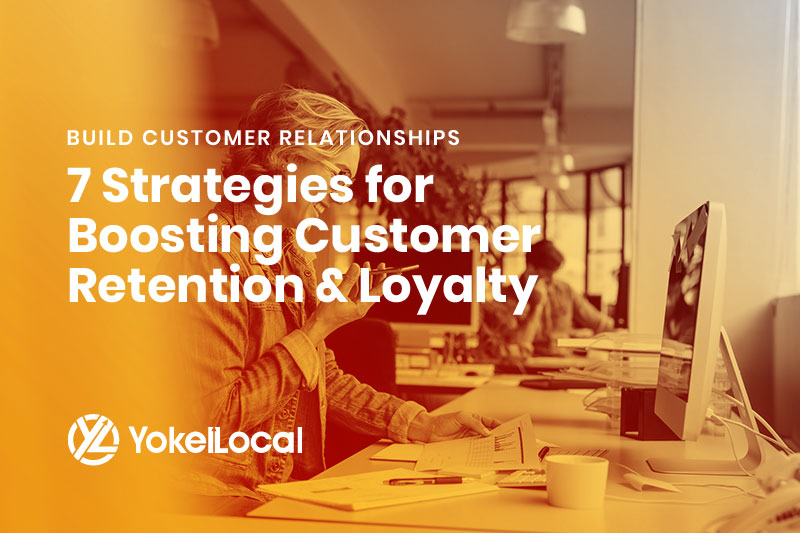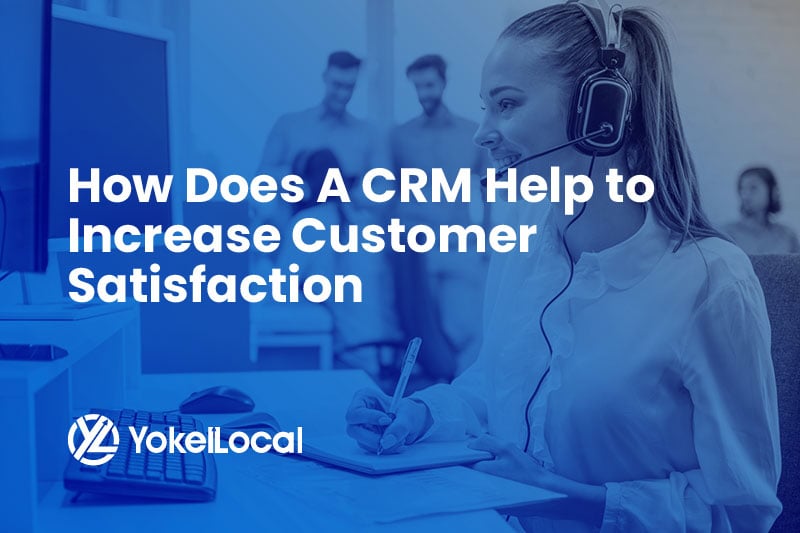Want your business to perform better? The answer could lie with your customers and how your organization relates to them.
There are several strategies for building strong relationships with customers. Leveraging them can transform your bottom line and business as a whole. How?
First, it helps to learn why your business should strive to build durable and lasting relationships with its customers - and what changes you'll need to implement to make this possible.
The Importance of Building Customer Relationships
The long-term success of your organization depends on the rapport it can build with customers over time. Today's customers are constantly evaluating the relationship they have with the brands in their lives, and a few missteps could cause your company to get dumped. On the other hand, if you can consistently impress your customers with caring, personalized service, you can dramatically increase their lifetime value.
“Always remember that everyone with whom you have a relationship has an invisible sign on their forehead that says ‘Make Me Feel Important.’ Treat them accordingly.”
— Eric Philip Cowell, Estate Agent Developer & Music Industry Executive
There are three primary benefits of building and maintaining strong customer relationships:
Reduces Churn
We get it, obtaining a new customer is exciting. However, if you don’t have a retention strategy, customer acquisition is wasteful and expensive. Over the last five years, customer acquisition costs have increased 50%.
Also, consider the following:
- Your current customers have a 50 percent chance of being interested in purchasing a new product and are likely to spend 31% more versus a new prospect.
- Your business is 14 times more likely to sell to a current customer than a new one.
- Focusing on your current customer base can increase profits anywhere from 25% to 95%.
Recommended Reading: Customer Churn: 6 Reasons You're Losing Customers
Boosts Customer Lifetime Value
Customer Lifetime Value (CLV) refers to the total revenue a business can expect from a customer over the course of the business relationship. Your CLV can be improved through customer satisfaction (and retention.) How so?
Satisfied customers have a healthier relationship with your business, causing them to make more (and larger) purchases in the future.
According to Forbes, customers are willing to pay 17% more for products from companies with great service. Satisfied customers are also five times more likely to make another purchase and four times more likely to make a referral.
Develops Brand Advocates
Brand advocacy happens when your customers become your biggest cheerleaders.
What this means is that your customers will organically support your business and rave about your brand to any and everyone who is willing to listen (hello word-of-mouth marketing). Studies have found that 92% of consumers trust word-of-mouth recommendations, while 82% of consumers proactively seek recommendations from their peers.
How to Build Strong Customer Relationships to Boost Loyalty
The key to building strong customer relationships, no matter the size of your business, is to engage your customers. It begins with these seven strategies:
1. Write killer emails
Wall Street Journal best-selling author and digital marketing titan Ann Handley says email, especially in the form of a newsletter, remains one of the best ways to reach people online.
"Newsletters are vastly undervalued and they're a huge opportunity that we're not doing well."
Every email you send out is a chance to build a connection with a potential customer. Yours should provide value and be personalized to the preferences of the human being on the other end, as well as where they are in their customer journey. You’re trying to be a part of someone’s life for the long haul, right?
No one wants to hear from someone they haven’t heard from in a while who is just asking for money. Likewise, you don’t only want to reach out to your customers when you have something to sell. Instead, keep them up to date on the latest happenings within your business or industry, send them special offers around the products or services they’re most interested in, and continue to educate them by being a source of valuable information. When they’re ready to buy, they’ll know where to find you.
2. Embrace pathological empathy
Handley also talks about the need for marketers to practice "pathological empathy." So, what does this look like for you? You can’t foster good customer relationships if you don’t understand your customers and tap into their emotions and psyche. This means looking for past simple demographic stats to the motivations of your customers - why do they need you?
Try creating detailed buyer personas that explore these intangible factors driving your customers’ purchase decisions. You can create these idealized personas for one, several, or many of your customer archetypes. When you get insights into what your customers expect, it makes it that much easier to communicate with them and deliver on your promise.
3. Blow away their customer service expectations
How does an upstart online pet food retailer take on Amazon and win? With ten-star customer service.
Chewy, Inc. is renowned for the care and attention it devotes to every customer, even going so far as to send flowers and a caring note if they learn that a customer’s pet died. The company was acquired for $3.5 billion by PetSmart in 2017 before going public in June 2019 and is currently valued at over $10 billion. There’s nothing a customer couldn’t get from Chewy that the world’s largest online retailer doesn't carry, yet Chewy boasts a loyal and growing customer base.
Likewise, your business can gain a massive edge by pouring its heart into every customer interaction. Customers value rapid and open communication along with a frictionless sales and returns process. Train your team to engage in active listening, to use positive language, and to display empathy in all of their customer interactions. Develop policies to do all of this and more - then commit to raising the bar at every opportunity.
4. Seek feedback and show you genuinely care
Customer feedback is critical to your ongoing success because you get to hear directly from your customers about what is and isn’t working. They want ways to leave feedback on your website, across social media, and over the phone and to see that their recommendations are being implemented.
Get ahead of your customers and ask them for feedback first. You'll show that you value their opinion and that you care about what they have to say.
The first step is to encourage open feedback on your website, via email, or through social media. After recording feedback, set up meetings with employees to find out how you can improve. A team that openly discusses ways to enhance products will prevent issues in the future once recommendations are implemented.
5. Be consistent and timely in your interactions
Customers value consistency. They will not tolerate rudeness, neglect, or failure to deliver on promises.
Engage and connect regularly; your customers expect it. No one wants to be left out of the loop and contacted when you only have something to sell.
Develop a policy in your organization that outlines the manner and frequency with which you'll reply to clients. Don't use scripts and keep your interactions organic. Be sure to take notes of the interaction and keep them in a place that your entire staff can access if needed to maintain the relationship.
6. Establish trust
Building trust is about being honest and open, even when it’s not a good look.
For example, if it will take an extra week for a product to be delivered or if a customer submits a request, such as a change to their website by a specific date, and you know you want to meet that deadline, let them know.
In most cases, a customer will be appreciative that you’ve kept them in the loop. Keeping them in the know builds trust.
When in doubt, ask yourself, “What is the best way to serve our customers?”
7. Reward loyalty
Find a way to reward your most loyal customers to show them that they are top-of-mind.
Develop a loyalty program for your best customers and offer them free gifts, samples, or points toward rewards. You can also offer them special deals, discounts, or early access to new items. Once outsiders hear about these offers, they’ll also want to get in on the action.
Think of these incentives as an investment to retain customers. Be creative and remember to give them what they will appreciate.
Nurturing & Managing Customer Relationships with CRM
How will you deliver seamless interactions above and beyond customer expectations at every single touchpoint? One of the most effective ways to nurture such relationships with the strategies mentioned above is through Customer Relationship Management (CRM) software.
A CRM is a platform that can ultimately improve your business's profitability and strengthen its customer relationships. Our personal favorite, the robust HubSpot CRM, allows users to capture an individual customer's purchasing history, revenue patterns, online behavior, and interactions with your company. (Plus, it’s free!) This information can then be made available to anyone in the company to plan for adjustments so that customers can enjoy seamless, engaging interactions that take them down the sales funnel.
How to Use HubSpot CRM Software to Develop Customer Relationships
Here’s how you can leverage the free HubSpot CRM to boost your CLV:
- Store and manage 1 million contacts
- Timelines of all interactions for each contact
- Contact and pipeline management
- Instant notifications when a contact clicks a link, opens an email, or downloads a document
- Gmail and Outlook integration for easy email tracking, notifications, templates, and scheduling
- Communicate with website visitors and customers via live chat
- Ticketing system to monitor customer requests and the time to close them
- More than 200+ integrations
- Reporting dashboard and analytics to optimize interactions
Creating a Customer Retention Strategy for Your Business
The truth is, great customer relationships aren’t built overnight, making it essential to cultivate and nurture them at every touchpoint.
When an organization is successful in doing so, it can lead to increased loyalty, a better reputation, and greater sales. Part of this requires a change in mentality within your business to make it more structurally receptive, open, and friendly. Focus more on inbound digital marketing strategies to make this happen. Another part of this transformation requires the adoption of CRM technology and its utilization across your organization.
A bit of creativity, active listening, and appreciation are the ingredients to successful customer relationships. Now that you have a better understanding of how to retain customers and further develop relationships, you can begin applying it to grow your business.














